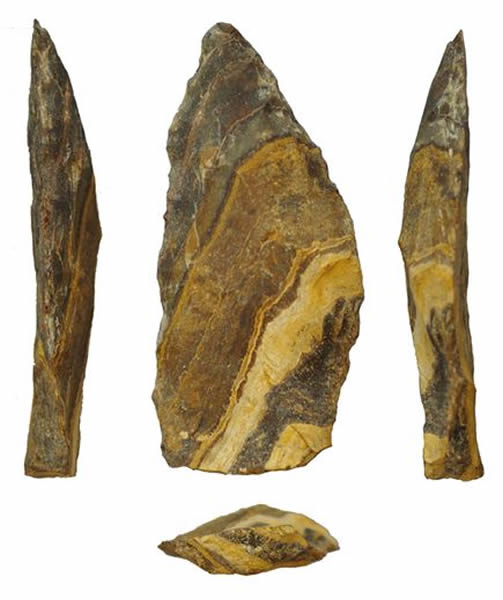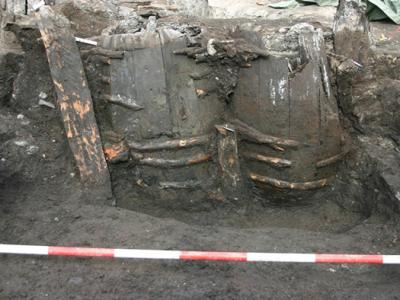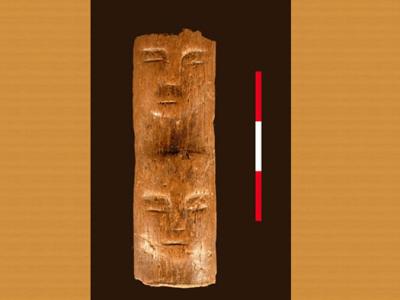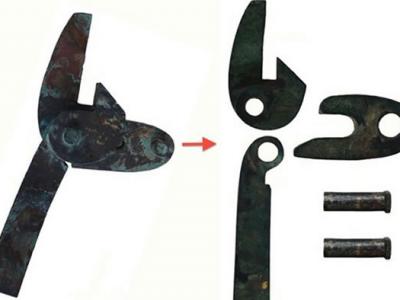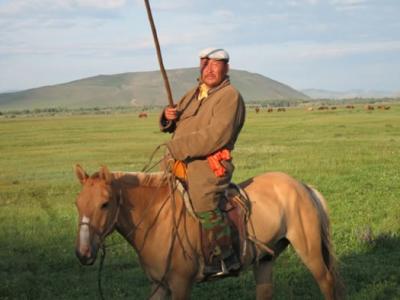Stone Spear Tips Surprisingly Old
Seen from four angles, a South African stone was likely shaped for a spear.
Some of our early human ancestors may have been smarter, and deadlier, than we thought, according to a new study of what may be Earth's oldest stone spear points.
If the dating is correct, it suggests our evolutionary forebears mastered the art of the stone-tipped spear half a million years ago—some 250,000 years earlier than previously thought.
Discovering that the world's oldest known spear points may come from a Homo heidelbergensis site is "like finding an iPod in a Roman Empire site," said paleoanthropologist John Shea, who wasn't part of the study. "It's that level of weirdness."
But it isn't weird to imagine these stocky big-game hunters using stone tools or even wooden spears in what's now South Africa. Until now, though, there's been no evidence H. heidelbergensis had the know-how to put the two together.
To fasten a handle to a blade—a technique called hafting—a prehistoric hunter likely would have had to procure a stone blade, a wooden shaft, twine woven from plants or animal sinew, and glue made from tree resin. The glue itself may have required a mastery of fire, to liquefy the resin, said Shea, of New York's Stony Brook University.
Supplies in hand, the toolmaker would have had to assemble the spear sturdily, "so you don't get killed the first time you use it on a Cape buffalo," Shea said.
Tip of the Tongue
Hafting would have been worth the work, because once you add a stone blade, a spear is "going to cause a lot more damage, create more bleeding, and cause the animal to die quicker," said University of Toronto anthropologist Jayne Wilkins, lead author of the new spear-tip study, released Thursday by the journal Science.
By allowing more efficient hunting, Wilkins explained, the spear "means more reliable and regular access to meat." And scientists agree that more meat in the diet meant increased human brain size. That's not just an increase in brain tissue, she added. The increase in size hints at intellectual expansion. The hafting process requires forethought. "You have to plan days in advance before actually being able to use your weapons to hunt," she said. And you'd want to teach your comrades to do the same, presumably by talking.
For Stony Brook's Shea, there's "no question" that hafting involved speech. "It would probably not be something that could be taught by imitation. This is a technology that is so complex that it absolutely, positively requires language."
The idea that H. heidelbergensis may have had language may not be especially shocking, given that the species is theorized to be the last known common ancestor of both Neanderthals and our species, Homo sapiens.
"We have language, and Neanderthals likely had language ... so it stands to reason that our last common ancestor had linguistic abilities too," Shea said.
Proof of Concept
Bearing telltale marks at their bases and impact fractures at their tips, the stones were unearthed in the 1980s at a Kalahari Desert site called Kathu Pan 1. But it wasn't until 2010, though, that scientists were able to date the sediments that had held the shaped stones.
Even then "we didn't know what their function was," study leader Wilkins said. "Because, even though they look a lot like [later] points that were used as spear tips, they might also have been used for cutting and scraping. So we had to make sure they were actually spear tips."
To do so, the team made copies of the Kathu Pan finds and jabbed them into a springbok carcass. Computer analysis later showed that both the prehistoric spear points and the replicas sustained similar damage.
The technique is a "big leap forward," said Stony Brook's Shea, who praised the researchers for inventing a way to "measure the damage on the edges and compare it objectively and quantitatively to experimental pieces.
"Now," he said, "nobody has an excuse for not doing that."
One-of-a-Kind Find?
The age of the spear points remains a matter of debate. If they are really a half million years old, why haven't we found them at later sites? The gap—between 500,000 and 250,000 years ago, is richly represented by archaeology, Shea said. But we haven't found stone spear tips. Why not?
It's possible, Shea said, that the technology was simply lost, only to be invented all over again thousands of years later. But "I don't think it's likely this is something that people invented and then abandoned," he said. "You wouldn't expect that kind of complexity to vanish completely."
There's another mystery, Shea explained. It's not just stone spear points that seem to be missing from other H. heidelbergensis sites. "If they could make glue, they should have been able to make other complex substances and artifacts, even ceramics," he said. But there aren't any. And, he added, if H. heidelbergensis could put stone tips on handles, you ought to see other tools, like axes, with stone tips and handles.
University of Connecticut paleoanthropologist Sally McBrearty—who, like Shea, did not participate in the research—agreed. "I think the authors have demonstrated that the artifacts are spear points," McBrearty said. "I'm a little less sure of the dating."
The Dating Scene
To be fair, dating at Kathu Pan 1 isn't exactly easy. There just aren't that many methods that work at the South African site, explained study co-author Michael Chazan, a paleoarchaeologist at the University of Toronto.
Radiocarbon dating, for example, is ineffective on artifacts hundreds of thousands of years old. And a process called argon dating requires volcanic rock, nonexistent at Kathu Pan 1.
Using a technique called electron spin resonance dating, the team dated a zebra adjacent to the points to roughly 500,000 years ago. And they dated sediments around the stones using optically stimulated luminescence, which gauges how long ago sunlight last struck a sample. That technique is relatively new, though, and can yield different dates depending on the assumptions made about the geologic history of a site, the study authors admit.
Perhaps the only way to strengthen the case for the spear points' surprising age is to find similar weapons at sites that have already been reliably dated, Chazan and Shea agreed.
Shea said he'll be on the lookout next year, when his team will head to East Africa for National Geographic Society-supported fieldwork unrelated to the Kathu Pan 1 project. "We'll see if we can find these things," he said.
Overall, the search, Chazan said, is just getting underway.
"We have only begun to have the ability to date assemblages in this time range in southern Africa," he said, "so it is hard to say whether what we have found is an anomaly. I suspect it is not."
World Domination
At least one thing seems sure: Strapping a blade to a stick helped make us who we are today, according to Arizona State University anthropologist Curtis Marean.
Just last week Marean, a National Geographic grantee, co-authored a study suggesting that some 70,000 years ago modern humans developed a lasting technique for making stone-tipped projectiles—arrows as well as spears specifically designed to be thrown. These, he says, gave us an edge over Neanderthals.
Together, Marean added, the two new studies may "document a two-step process of projectile-weapon evolution that ultimately allowed modern humans to conquer the planet."
Ker Than
for National Geographic News
Published November 16, 2012
